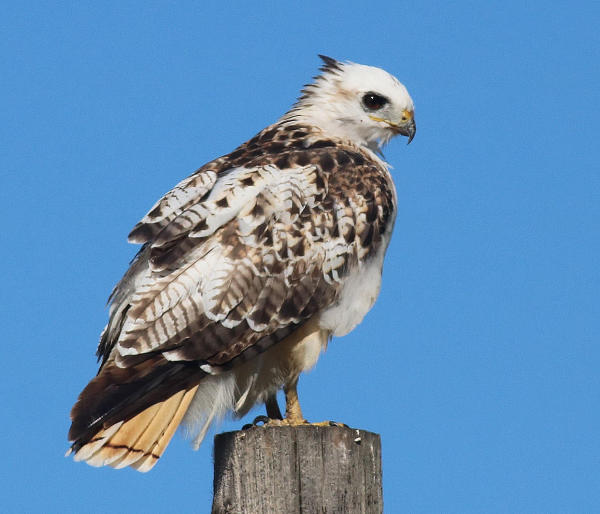
Krider’s Red-tailed Hawk
|
Paul began this week’s visit: Krider’s Red-tailed Hawks have been moving into the area in earnest this week; I’m seeing an average of two per day. Mid-August is the start of more serious hawk migrations across the high plains and Krider’s Redtails are the most obvious of the rarer raptors that stop here for a day or a couple weeks between now and mid-October. Krider’s are distinguished by a white head and undersides with varying amounts of white plumage coloration on their back and tail; some Krider’s have almost white tails.
The most exciting of my Krider’s sightings was seeing an old friend, a particular male Krider’s that has returned to the same location during at least the past four fall seasons, and the past two springs (all the springs and falls I’ve been in the Northern Great Plains this decade). This Krider’s is very trusting, and it’s interesting to monitor his tail molts in particular.
Tuesday, he appeared to have a totally white tail, although from past experience I know that white coloration is due to sun bleaching. During late summer he molts white tail feathers that are replaced by orange tail feathers. But Tuesday, when he turned to show me his backside Tuesday, I could see one new orange tail feather showing about three inches long from the base of its tail. He’s a fine example of a Krider’s Redtail, and I will undoubtedly update my sightings of him for you as the fall season progresses.
I was also excited to see the first Swainson’s Hawk fledglings Wednesday, although they were already pretty good fliers, so I’m guessing they fledged a week or 10 days before. Not much to report on the Ferruginous and Red-tailed Hawk fledglings I’ve been monitoring, except that they have expanded their home ranges and do not visit the nest sites anymore. I saw two of the Redtail fledglings about ¾ mile south of their nest site Friday, and one of the Ferruginous fledglings was perched about ½ mile from the nest Wednesday (west) and Saturday (north). Was this the same young Ferrug, or two different fledglings? It’s definitely harder to try to find the fledglings and get a feel for their success and survival during this critical post-fledging period [without telemetry equipment].
Overall, there are still more new duck broods hatching; most adult ducks have molted into eclipse plumage after flocking together in certain wetlands. I usually see one brood of pheasants somewhere each day. I’ve seen an adult Bald Eagle in the same region once or twice a week during the past month, which is unheard of here at this time of year. A few flocks of shorebirds can be seen in the area – notable this week was a flock of American Avocets in alternate plumage. It’s a robust year for berries in the area, and this week many robins stripped the chokecherry grove in my backyard.
The oriole action at my grape jelly feeder has been great fun to watch this week. At times I have five orioles at a time, and that may or may not include a family group of Orchard Orioles that sometimes comes as a group of four. The fledglings visit on their own or in tandem, but when they come with one or both adults, they still beg for an adult to feed them, and they are usually fed as a result. Baltimore Orioles seem to be even more abundant, with many female and immature birds feeding here, with at least two striking males making rare but regular visits. Would you believe I didn’t see an oriole in this area all last summer and fall?
I’m excited about what lies ahead for this birder next week! How ‘bout you Peter?
Peter responded with his own level of excitement: I spent a morning this week at the Phinizy Swamp Nature Park in Augusta, Georgia, to check out this regional hotspot. The core of this 1100-acre facility is a series of wetland cells created to treat stormwater. The cells are filled with vegetation and provide superb bird habitat, and the dikes surrounding the cells make for easy bird viewing and photography.
There were dozens of Little Blue Herons, including slate-blue adults, white juveniles and calico immatures that were half-and-half. Small flocks of White Ibis circled. King Rails called. I came across an immature Cooper’s Hawk plucking feathers from its prey.
Best birds of all, though, were a Pied-billed Grebe hatchling and adult floating on open water. The downy little grebe wasn’t much larger than a sparrow, but it swam and dove with ease. The striking black and white “camo” pattern on its head was amazing through my binoculars. Grebes are well-known for carrying their hatchlings on their backs, but I didn’t get to see this behavior. At one point the little grebe was startled and dove into the water, surfacing about 10 feet away. I was amazed that this tiny bird could swim submerged for such a distance. Sometimes it’s the little things that are the most interesting.
Photographs by Paul Konrad
Peter Stangel and Paul Konrad are the editors of The Birding Wire and can be reached at editorstbw2@gmail.com to share your favorite birding sightings and photos.